George Edwin Britnell
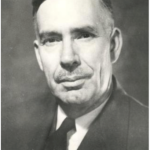
George Edwin Britnell was born on June 9, 1903 in Wimbledon, England. He came to Canada with his family in 1910. In 1913, the family moved to a homestead near Macrorie, Saskatchewan. George attended primary schools in Outlook and Prince Albert. In 1924, George won the Governor General’s Gold Medal. He obtained a Bachelor of Arts degree in 1929 from the University of Saskatchewan. In 1930, George began lecturing in Economics at the University of Saskatchewan. In 1934, he obtained a Master of Arts degree from the University of Toronto. From 1935 to 1936, George was lecturer in Economics at the University of Toronto. In 1938, he received a PhD from the University of Toronto. In the same year, George became an Assistant Professor of Economics at the University of Saskatchewan.
He became Professor and Head of Political Science in 1938. In 1945, he became Professor and Head of the joint Department of Economics and Political Science. He fulfilled this position until 1961. From 1945 until 1951, George was a special advisor to the Government of Saskatchewan. In 1946, he was the chairman for the Saskatchewan Economic and Technical Committee on Transportation and Freight Rates. Much of his research during this time related to transportation issues. From 1947 until 1960, George was a member of the Social Science Research Council of Canada where he had a voice on policy formulation and development.
George was also an accomplished author. He wrote many articles for the Western Producer. In 1939, he published a novel entitled The Wheat Economy, which commented on the standard of living in Saskatchewan. A number of George’s publications from 1945 related to his interest in transportation.
George received many honours throughout his life. In 1950, he was elected Fellow of the Royal Society of Canada. In the year 1954 to 1955, George was the first Harold Innis Visiting Research Professor of Political Economy at the University of Toronto. In 1956, he was president of the Canadian Political Science Association. After a lengthy illness, George passed away on October 14, 1961 in Saskatoon.
George formerly resided at 1121 Elliott Street.
This information was gathered from the following sources:
– Fowke, V.C. (1962). George Edwin Britnell, 1903-1961. The Canadian Journal of Economics and Political Science, 28, 283-291.
– Henderson’s Saskatoon Directory, 1950.
– University of Saskatchewan, University Archives & Special Collections, G.E. Britnell
Fonds (MG 41). Finding aid (biographical note).
Mary Yvonne Carter
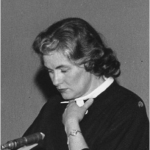
Mary Yvonne Carter (nee Munn) was born on October 11, 1923 in Cromer, Manitoba. In 1938, she moved to Saskatoon with her family. She graduated from Nutana Collegiate in 1941. From the University of Saskatchewan, she received a Bachelor of Arts Degree in 1944 and a Bachelor of Laws degree in 1947. In 1947, she married fellow law graduate Roger Carter. From 1948 until 1953, Mary practiced with Roger at the law firm Makaroff, Carter & Carter.
In 1960, Mary was appointed a magistrate and was only the second woman in Saskatchewan to do so. Mary often dealt with cases involving marriage disputes, child custody, and cases involving young offenders. In 1978, Mary became part of the Saskatchewan District Court where she participated in the project of a Unified Family Court. In 1981, she became a judge of the Court of Queen’s Bench and held this position until her retirement in 1998. Mary passed away in 2010.
Mary formerly resided at 420 Cumberland Avenue South.
This information was gathered from the following source:
– Bilson, B. (n.d.). Carter, Mary Yvonne (1923-2010). In The Encyclopedia of Saskatchewan. Retrieved from http://esask.uregina.ca/entry/carter_mary_yvonne_1923-.html
– Henderson’s Saskatoon Directory, 1955.
– The StarPhoenix, Mary Carter Obituary, October 6, 2010.
Roger Colenso Carter
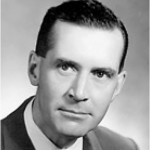
Roger C. Carter was born on March 23, 1922 in Moose Jaw, Saskatchewan. Prior to attending the University of Saskatchewan, Roger attended school in Victoria. From the University of Saskatchewan, he earned a Bachelor of Arts degree in 1945 and a Bachelor of Laws degree in 1947. In 1947, he married fellow law graduate Mary Munn, who went on to become the second female magistrate in Saskatchewan. From 1949 until 1963, Roger practiced in Saskatoon with the law firm Makaroff, Carter & Carter. For six years, he worked with his wife Mary Carter at this law firm.
During his time of practice, Roger was involved in many organizations including the Graham Royal Commission, Council for the Province of Saskatchewan, and a member of the University of Saskatchewan’s Board of Governors. In 1963, he was appointed Associate Professor of Law at the University of Saskatchewan. He became a Professor of Law in 1964. From 1967 to 1968, Roger undertook the Cook Fellowship at the University of Michigan School of Law. He also received a Master of Law degree from the University of Michigan in 1968. Roger returned to Saskatoon and was the Dean of the College of Law at the University of Saskatchewan from 1969 until 1974. He was also named Professor Emeritus in the College of Law.
Roger is credited with being the founder of the Native Law Centre (he was the first Director) at the University of Saskatchewan and was also important in establishing Saskatchewan’s Legal Aid System. In 1981, the Roger Carter Scholarship was established by the Native Law Students Association of Canada. The scholarship provides up to four grants to Native Canadian students entering their second or third year of legal studies. Roger was awarded an honorary doctorate in Law from Queen’s University in 1981. In the 1980s, Roger served on the CBA Native Justice Committee. In 1989, Roger received the Companion of the Order of Gabriel Dumont and also became a member of the Indigenous Bar Association in the same year. He was awarded the Saskatchewan Order of Merit and the Distinguished Service Award in 1998. Roger is one of the founding members of the law firm Robertson Stromberg.
Roger formerly resided at 420 Cumberland Avenue South.
This information was gathered from the following sources:
– Henderson’s Saskatoon Directory, 1955.
– Roger Carter Scholarship Recipients Announced (November 19, 2012). Retrieved July 8, 2014 from University of Saskatchewan College of Law Website, http://law.usask.ca/news/roger-carter-scholarship-recipients-announced.php
– Roger C. Carter, Q.C. (n.d). Retrieved June 25, 2014 from Robertson Stromberg Website, http://www.rslaw.com/about-us/history/carter/
– The StarPhoenix, Roger Carter Obituary, February 12, 2007
– University of Saskatchewan, University Archives & Special Collections, R.C. Carter fonds (MG 161), finding aid (biographical note).
William Pollack Fraser
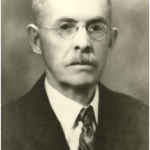
A-3375. Portrait of WP Fraser (1867-1943) of the Biology Department, ca. 1943
William Pollack Fraser was born in 1867 in French River, Nova Scotia. He received degrees from Dalhousie and Cornell Universities. He was head of the Dominion Laboratory of Plant Pathology from 1919 until 1925. William focused much of his time on researching plant rust in Canada. Other areas of research that he focused upon were physiologic races of stem rust, resistance of wheat stem rust, and control of cereal smuts.
William joined the University of Saskatchewan as a professor of biology in 1925. He retired from the University of Saskatchewan in 1937. Upon his retirement, he was made Professor Emeritus and awarded an honorary doctoral degree in Law. He died on November 23, 1943. Fraser Crescent in Greystone Heights is named in his honour.
William formerly resided at 1021 College Drive.
This information was gathered from the following sources:
– Duerkop, J. (2000). Saskatoon’s History in Street Names. Saskatoon: Purich Publishing Ltd.
– Henderson’s Saskatoon Directory, 1941.
– University of Saskatchewan, University Archives & Special Collections, W.P. Fraser fonds (MG 91), finding aid (biographical note).
David Eldon “Tom” Gauley
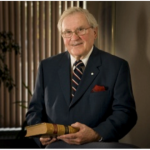
https://words.usask.ca/donornews/2013/01/07/tom-gauley-prize-established-in-law-honours-prominent-saskatoon-lawyer/#more-38
Tom Gauley was born in Unity, Saskatchewan on October 15, 1922. In 1943, Tom graduated from the University of Saskatchewan with a Bachelor of Laws degree. That year, Tom was called to the Saskatchewan Bar. In 1945, he formed his own law firm Francis, Woods, and Gauley. From 1950 until 1962, Tom was a lecturer in the College of Law at the University of Saskatchewan. In 1956, he was appointed to Queen’s
Counsel. That year, he helped establish the first Bar Admission Course for the Law Society of Saskatchewan and was the president of the society in 1966.
In 1978, Tom served as Saskatchewan’s representative on the “Committee on the Constitution,” which advised and analyzed the Constitution. Tom was Saskatchewan’s representative when the Canadian Bar Association produced its report “Towards a New Canada” in 1979. The document was produced during the tenure of Pierre Trudeau and was the first attempt by the federal government to repatriate the Constitution.
Over the years, the law firm Francis, Woods, and Gauley has evolved. At one point, it was the Francis, Woods, Gauley, and Hughes law firm. Since 2001, the law firm has been known as McDougall Gauley.
In 2012, Tom was the recipient of the Queen Elizabeth II Diamond Jubilee Medal for being an individual with “outstanding commitment to the communities they call home and to the people in Saskatchewan”. In the same year, the Tom Gauley Prize in Common Law Studies was established at the University of Saskatchewan to mark the prominent Saskatoon lawyer’s 90th birthday and the contributions he has made to the law profession. The annual prize is awarded to the first year law student with the highest blended average in a first year common law subject.
Tom formerly resided at 1427 Main Street.
This information was gathered from the following sources:
– Canadian Plains Research Center (n.d.). Gauley, David E. (1922-). In The Encyclopedia of Saskatchewan. Retrieved from http://esask.uregina.ca/entry/gauley_david_e_1922-.html
– Henderson’s Saskatoon Directory, 1965.
– Spray, H. (2012, October, 11). Lawyer turning 90 comes to work day in, day out. Star-Phoenix.
– University of Saskatchewan (2013). Tom Gauley Prize Established in Law Honours Prominent Saskatoon Lawyer. In U of S Donor News Releases. Retrieved from https://words.usask.ca/donornews/2013/01/07/tom-gauley-prize-established-in-law-honours-prominent-saskatoon-lawyer/#more-38
Victor Edward Graham
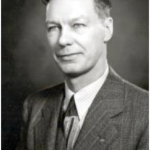
V.E. Graham was born in Arundel, Quebec in 1900. In 1927, he received a Bachelor of Science in Agriculture from the University of Saskatchewan.
From the University of Wisconsin, Victor received both his Master’s degree (1930) and Ph.D. (1939).
He was appointed the Dean of the College of Agriculture at the University of Saskatchewan in 1948 until he retired in 1964.
Victor formerly resided at 1009 Temperance Street.
This information was gathered from the following sources:
– Henderson’s Saskatoon Directory, 1941.
– University of Saskatchewan, University Archives & Special Collections, VE Graham fonds, finding aid (biographical note).
Alexander Rodger Greig
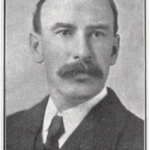
Alexander Rodger Greig was born on December 18, 1872 in Montreal and graduated with a degree in Mechanical Engineering from McGill University in 1895. In 1906, Alexander was appointed as Professor of Agricultural Engineering at the Manitoba Agricultural College. He was one of the first professors appointed at the University of Saskatchewan.
In 1909, he accepted two positions at the University of Saskatchewan. He was Professor of Mechanical Engineering until 1937 and Superintendent of Buildings until 1939. While Superintendent of Buildings, Alexander directed the building of the President’s Residence from 1910 until 1913. After fulfilling these positions in Saskatchewan, he moved back to Alberta. From 1939 to 1943, he was an Acting Professor of Mechanical Engineering at the University of Alberta. He died on July 21, 1947. Greig Avenue in Sutherland is named in his honour.
As early as 1915, Alexander resided at 409 Clarence Avenue North.
This information was gathered from the following sources:
– Duerkop, J. (2000). Saskatoon’s History in Street Names. Saskatoon: Purich Publishing Ltd.
– Henderson’s Saskatoon Directory, 1915.
– University of Saskatchewan, University Archives & Special Collections, A.R. Greig Fonds, 19, Greig, Alexander Rodger, 1872-1949 (Professor of Mechanical Engineering), 1929-1949.
Evan Alan Hardy
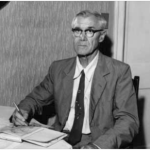
Saskatoon Public Library-Local History Room
Evan Alan Hardy was born in Sioux City, Iowa in 1890. Evan’s passion and skills in repairing farming machines turned his attention towards engineering school. In 1917, he received an engineering degree from the University of Iowa. Having heard about the struggles faced by Saskatchewan farmers because of the war (not enough labour to produce the grain needed), Evan applied and was accepted for a teaching position at the University of Saskatchewan in 1917.
Evan was not only a teacher at the University of Saskatchewan, but was also involved with local agricultural organizations. He taught local agricultural organizations about strategies to improve the plowing skills of farmers and travelled to small towns in rural Saskatchewan to teach courses on farming mechanics and gasoline engines. Evan was also very dedicated to his students. He was one of the founders of the student branch of the American Society of Agricultural Engineers and held an annual banquet at his home for future engineers. Evan was also a dedicated member of his community. For more than 30 years, he taught Sunday school at Grace United Church.
After a long and distinguished career, Evan left the University of Saskatchewan in 1951. He took a position as an agricultural engineer in Ceylon for the Food and Agriculture Organization of the United Nations. He helped in developing processes for dry land farming, irrigation projects, improvements to the transportation system, as well as developing a harbour plan to accommodate large ocean vessels. While in Ceylon, he taught civil, mechanical, electrical, and agricultural engineering to farmers along with soil and plant science courses. Evan died on December 4, 1963 in Sri Lanka. Throughout his life, Evan received many awards and many institutes are named in his honour (including the University of Saskatchewan Engineering Buildings). Evan was inducted into the Saskatchewan Agricultural Hall of Fame in 1973. Hardy Crescent in Greystone Heights is named in his honour.
Evan Hardy Collegiate, located at 605 Acadia Drive is named after Evan. The school opened in 1965 and serves students from grades 9 to 12.
Evan formerly resided at 1011 University Drive, 826 10th Street East, 1037 Aird Street, and 409 Clarence Avenue North.
This information was gathered from the following sources:
– Duerkop, J. (2000). Saskatoon’s History in Street Names. Saskatoon: Purich Publishing Ltd.
– Henderson’s Saskatoon Directory, 1941.
– Hislop, M.W. (1987). Evan Hardy- a pioneer of modern agricultural technology. LIAISON: Saskatchewan Heritage Review 4, 3-6.
– Saskatchewan Agricultural Hall of Fame. (2013). Saskatchewan Agricultural Hall of Fame 25th Anniversary. Retrieved from http://www.sahf.ca/memindx.php
– Saskatoon Public Schools (2013). About Our School. Retrieved from http://www.spsd.sk.ca/school/evanhardy/About/Pages/default.aspx
Louis Horlick
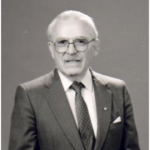
Louis Horlick was born on December 2, 1920 in Montreal. In 1944, he received a Bachelor of Science degree from McGill University. He received a Doctor of Medicine and Master of Surgery degree from McGill University in 1945 and a Master of Science in Experimental Medicine in 1953. In 1952, he married Ruth Horlick (nee Hood), a nurse at the Royal University Hospital.
In 1954, Louis became a Lecturer in Medicine and Biochemistry at the University of Saskatchewan. He became a full Professor of Medicine and Cardiology in 1962. In 1967 and in 1979, he was the Acting Head of the Department of Medicine. He was the head of this department from 1968 until 1974. Aside from being a professor at the University of Saskatchewan, Louis was also on the Board of Governors.
Louis retired in 1989. Aside from his academic career, Louis was also on staff at the Royal University Hospital as well as an attending physician at City Hospital. Louis was an accomplished author, having authored more than 60 scholarly papers, most of which focused upon topics such as modifying risk factors in coronary heart disease. Louis has also received many honours, including the Saskatchewan Order of Merit in 1991 for his effort in establishing a 9-1-1 system in Saskatchewan and his volunteer work with the Saskatchewan Heart Foundation. In 1995, Louis received the Order of Canada. The Lou Horlick “Spirit of the College of Medicine Award” is named in his honour and awarded to an individual associated with the College of Medicine who shows spirit, dedication, and enthusiasm throughout their work. The Louis Horlick Chair of Medicine was introduced in January 2012 and recognizes the contributions Louis made to the field of medicine. The Head of the Department of Medicine is bestowed this title. Louis passed away on October 23, 2012. Horlick Crescent in Arbor Creek is named in his honour.
Louis formerly resided at 1215 Elliott Street and 320 Munroe Avenue South
This information was gathered from the following sources:
– Duerkop, J. (2000). Saskatoon’s History in Street Names. Saskatoon: Purich Publishing Ltd.
– Henderson’s Saskatoon Directory, 1962.
– University of Saskatchewan, University Archives & Special Collections, Louis Horlick fonds (MG 184), finding aid (biographical note).
Ruth Horlick
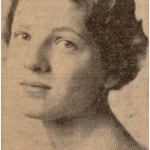
Ruth Horlick (nee Hood) was born on September 25, 1919 in Toronto. Ruth was raised in Ganonoque, Ontario. She received a Bachelor of Arts degree in 1941 from Queen’s University. She went on to receive her nursing degree from McGill University in 1947. Ruth undertook post graduate training in psychiatric nursing at the Royal Victoria Hospital in Montreal. She also worked at hospitals in Denver and Washington prior to moving to Saskatoon. In 1952, she married Lou Horlick, who made significant contributions to the field of medicine. She accepted a position at the University of Saskatchewan and became involved in psychiatric group therapy. Ruth also worked at the McKerracher Centre, which is a psychiatric day care facility. In 1977, Ruth began working at the Royal University Hospital.
Ruth was instrumental in creating the Association for Children with Learning Disabilities. Ruth was well known for her volunteer work. She was a regular volunteer tutor at the Regional Psychiatric Centre in Saskatoon. Her other volunteer work included being a patron of the Saskatoon Crisis Nursery, president of the Royal University Hospital Auxiliary, first president of the Saskatoon Symphony Volunteers, and a board member of the Meewasin Foundation.
Among the many awards Ruth has received are the Canada Volunteer Award in 1988, the YWCA Woman of the Year Award in 1989, the Correctional Service of Canada Volunteer Award in 1990, and the Canada Confederation medal in 1992.
Ruth formerly resided at 1215 Elliott Street and 320 Munroe Avenue South.
This information was gathered from the following sources:
– Henderson’s Saskatoon Directory 1962.
– Jackson, M. (n.d.). Horlick, Ruth (1919-). In The Encyclopedia of Saskatchewan. Retrieved from http://esask.uregina.ca/entry/horlick_ruth_1919-.html
– University of Saskatchewan, University Archives & Special Collections, Ruth Horlick fonds (MG 211), finding aid (biographical note).
Ted Hughes
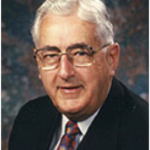
Awards and Prizes. Retrieved from http://awards.usask.ca/faculty/recipients/tedhughes.php
Edward “Ted” Hughes was born in Saskatoon, Saskatchewan. He earned both a Bachelor of Arts degree and a Bachelor of Laws degree from the University of Saskatchewan. From 1952 until 1962, Ted practiced law in Saskatoon as part of the law firm Francis, Woods, Gauley, and Hughes. In 1954, Ted married Helen Hughes, a former Saskatoon and Victoria City Councillor. In 1962, he was appointed District Court judge. In 1974, Ted was promoted to the Saskatchewan Court of Queen’s Bench and would fulfill this position until 1980. In that year, Ted moved to British Columbia and became a legal advisor to the provincial Attorney General.
Ted was appointed Deputy Attorney General in 1983. During his time in this position, Ted chaired a series of public hearings that focused on the government’s cuts to legal aids. From 1987 to 1988, Ted chaired a justice reform committee that created many structural changes in British Columbia’s judicial structure.
Ted served as federal chief land claim negotiator between First Nations groups on Vancouver Island. In 1990, he became British Columbia’s first Conflict of Interest Commissioner and he fulfilled this position until 1997. Ted served as Conflict of Interest Commissioner for the Yukon from 1996 until 2002. In 1996, Ted was appointed by the Government of Canada as a Chief Federal Treaty Negotiator for British Columbia. He fulfilled this position until December 31, 1998. From 2001 to 2005, Ted was the Commissioner of Conflict of Interest and Ethics Counsellor to the Public Service of the Northwest Territories.
In 2003, Ted was Federal Chief Adjudicator, settling claims involving alleged harms and abuse relating to attendance at Indian Residential Schools. Ted remained in this position until 2008. In 2005, he was appointed to review British Columbia’s Child Welfare System. Ted has also been chair of the Saskatoon City Hospital Board of Governors, the Saskatchewan Cancer Foundation, Juan de Fuca Hospitals in Victoria, and the Vancouver Island CNIB Capital Fundraising Drive. From 2008 to 2009, Ted served as co-chair of the Greater Victoria Coalition to End Homelessness.
Over his career, Ted has received many honours. In 1990, he received the Lieutenant Governor’s Award for excellence in the public service of British Columbia. In 1992, he was awarded the Canadian Bar Association President’s Medal for legal contributions to law in British Columbia. Ted received the Law Society of British Columbia Award in 2000. It is the highest award given by the Law Society, based on integrity, professional achievement, service, and reform. Ted was awarded the Queen’s Golden Jubilee Medal in 2002. In 2003, he received the Order of Canada. In 2009, he was awarded the Chancellor’s Community Recognition Award by Royal Roads University. In 2010, Ted was named by “Canadian Lawyer” magazine as one of the 25 most influential Canadians in the Canadian justice system and legal profession. He has also received Victoria Foundation’s Generosity of Spirit Award, Leadership Victoria’s Lifetime Achievement Award, and Queen Elizabeth II Diamond Jubilee Medal.
Ted formerly resided at 1410 13th Street East.
This information was gathered from the following sources:
– Henderson’s Saskatoon Directory, 1958.
– Royal Roads University (n.d.). Ted Hughes. In Award Recipients. Retrieved from
http://www.royalroads.ca/news-events/convocation/awards/ted-hughes-0
– The Canadian Bars Association (2011). The Hon. Ted Hughes, O.C., Q.C., LL.D. (Hon.).
Retrieved from http://www.cba.org/BC/sections_pdfs/pdf/doj_th_bio.pdf
– University of Saskatchewan (2011). The Honourable Edward (Ted) Hughes. In Awards and Prizes. Retrieved from
http://awards.usask.ca/faculty/recipients/tedhughes.php
John Francis Leddy
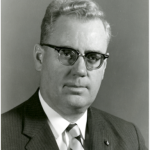
J.F. Leddy was born on April 16, 1911 in Ottawa. In 1930, he received a Bachelor of Arts and in 1931 he received a Master of Arts, both from the University of Saskatchewan. In 1932, John did postgraduate work at the University of Chicago. In the same year, he went to Oxford as the Saskatchewan Rhodes Scholar. From Oxford, he received a Bachelor in Literature in 1935 and a PhD in Philosophy in 1938.
John became a member of the University of Saskatchewan Classics Department in 1936 and by 1946, he was both a professor and head of the department. From 1945 until 1964, John was on the University Senate. He was the Dean of Arts and Sciences from 1949 until 1964. He was also the Vice President Academic from 1961 until 1964. In 1964, John was appointed the President of the University of Windsor.
John was instrumental in establishing the Canadian version of the Peace Corps. In June 1961 at a conference at McGill University, he established the Canadian University Service Overseas (CUSO), s program that sent young volunteers overseas to work on community development projects. In 1965, John was chosen by Prime Minister Lester B. Pearson to create the Company of Young Canadians. Individuals involved in this program stayed in Canada to work within disenfranchised communities.
He received honorary degrees from ten Canadian universities and an honorary degree from Hanyang University in Seoul, Korea. Leddy was also a layman in the Catholich Church and was appointed to the Papal Household by Pope Paul VI in 1969. In 1972, John was made an Officer of the Order of Canada. Leddy Crescent in College Park is named in his honour.
John formerly resided at 1342 Elliott Street.
This information was gathered from the following sources:
– CUSO International (2013). Our History. Retrieved from http://cusointernational.org/about-cuso/our-history
– Duerkop, J. (2000). Saskatoon’s History in Street Names. Saskatoon: Purich Publishing Ltd.
– Henderson’s Saskatoon Directory, 1941.
– St. Thomas More College (n.d.). J. Francis Leddy OC professor)- 1933. Retrieved from http://stmcollege.ca/alumni/rhodes-scholars.php
– University of Windsor (1998). U of W Leddy’s Legacy. Retrieved from http://web2.uwindsor.ca/newsstnd/uwflra/oct9801.htm
– University of Saskatchewan, University Archives & Special Collections, J.F. Leddy fonds (MG 11), finding aid (biographical note).
Walker Stewart Lindsay
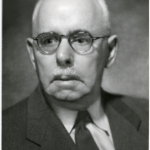
W.S. Lindsay was born in Halifax, Nova Scotia. He attended Dalhousie University and received a Bachelor of Arts degree. He attended the University of Edinburgh for medicine. Walker came to Saskatoon in 1919, where he became a professor of pathology and bacteriology at the University of Saskatchewan. In 1926, he became the first Dean of the newly formed School of Medical Sciences.
Walker retired from the University of Saskatchewan in 1952. From 1956 until 1960, he was the Assistant Medical Director at the Royal University Hospital. In 1955, he received an honourary doctor of Laws degree from the University of Saskatchewan at a ceremony marking the opening of the Royal University Hospital.
In 1971, the University of Saskatchewan established a named chair in the College of Education known as the W.S. Lindsay Professorship. In 1976, Walker became a member of the Canadian Association of Pathologists. The W.S. Lindsay Gold Medal in Nursing is named in his honour and is given annually to the student with the highest cumulative grade-point average in the entire nursing program that year. Lindsay Drive and Place in Greystone Heights are named in his honour.
Walker formerly resided at 1015 College Drive.
This information was gathered from the following sources:
– Duerkop, J. (2000). Saskatoon’s History in Street Names. Saskatoon: Purich Publishing Ltd.
– Henderson’s Saskatoon Directory, 1941.
– University Archives & Special Collections, University Library, University of Saskatchewan, RG 2087, Faculty Biographies, W.S. Lindsay.
Arthur S. Morton
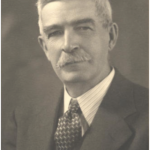
Arthur S. Morton was born on May 16, 1870 in Iere, Trinidad. He attended the University of Edinburgh and received a Master of Arts and a Bachelor of Divinity in 1896. That summer, he attended the University of Berlin and moved to Canada that fall. He was ordained by the Presbytery of St. John, New Brunswick and served as a minister until 1904. Arthur was church lecturer at the Presbyterian College in Halifax and the Knox College in Toronto. He came to the University of Saskatchewan in 1914 and was the Head of the History Department as well as the first librarian at the university until his retirement in 1940. In 1917, Arthur established a historical association named the Morton Historical Association. Students in the association were given the job of preserving material relating to the history of the Prairies. A museum committee was also created as a result of the Morton Historical Association.
In 1937, Arthus set up the Historical Public Records Office (HPRO) at the University of Saskatchewan, which served as the precursor to the present day Saskatchewan Archives Board (SAB). As the university librarian, Arthur was able to build up the supply of books relating to western Canada. The supply of books would be the foundation for the Historical Public Records Office and later the Saskatchewan Archives Board. Arthur believed that his colleagues would benefit from being involved in an archival organization. He believed that historians had a broader role to play and should not be limited to teaching, writing, and researching. According to Arthur, the university had a higher interest in government archives than did the government departments creating the archives. His goal behind establishing the Historical Public Records Office on the University of Saskatchewan campus was to make sure that material was preserved and made accessible to scholars studying the history of the Canadian West.
Over the course of his career, Arthur published several books, most focusing on Western Canadian history. Arthur is perhaps best known for his works titled A History of the Canadian West 1870-1871 published in 1939 and Saskatchewan: The Making of a University published in 1959. He also received many honours including being named Professor Emeritus, elected as a Fellow of the Royal Society of Canada in 1932, Keeper of Provincial Records in 1937 and Provincial Archivist in 1943.
The Vivian Williams Morton and Arthur Silver Morton Travel Scholarship at the University of Saskatchewan is named after Arthur and his wife Vivian (co-founder of the Saskatoon Arts and Crafts Society) and is given out annually to one or two students who have completed a degree or at least three full years of study in History, Anthropology, Political Studies, or Native Studies. The scholarship is designed to help students travel for research purposes. Arthur died on January 26, 1945. Morton Place in Greystone Heights is named in his honour.
Arthur formerly resided at 1005 Aird Street and 1004 15th Street East.
This information was gathered from the following sources:
– Champ, Joan. “Arthur Silver Morton and his Role in the Founding of the Saskatchewan Archives Board.” Archivaria 32 (1991): 101-112.
– Duerkop, J. (2000). Saskatoon’s History in Street Names. Saskatoon: Purich Publishing Ltd.
– University of Saskatchewan, University Archives & Special Collections, A.S. Morton Manuscript Collection (MG 2), finding aid (biographical note).
– University of Saskatchewan (2014). Vivian Williams Morton and Arthur Silver Morton Travel Scholarship. In University of Saskatchewan Department of History. Retrieved from http://www.arts.usask.ca/history/give/
Walter Charles Murray
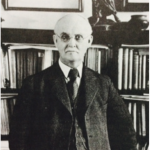
Walter Charles Murray was born on May 12, 1866 in King’s County, New Brunswick. In 1886, Walter received a Bachelor of Arts degree from the University of New Brunswick. In 1891, he received a Master of Arts degree in Philosophy from the University of Edinburgh. Prior to being appointed the first president of the University of Saskatchewan in 1907, he taught philosophy at Dalhousie University.
Walter remained President of the University of Saskatchewan until he retired in 1937. During his tenure at the university, much controversy surrounded agricultural education. In trying to resolve this controversy, Walter successfully integrated the College of Agriculture with other colleges on campus.
Walter also sat on various public offices. Some of these various positions included being on the board of trustees for the Carnegie Foundation and being the Chair of the Board of Governors for the Saskatoon City Hospital. Walter received honorary degrees from several universities across Canada and in the United States. Due to his vision for a “people’s university” as well as his community service, Walter is known to many people as the “Prairie Builder”.
Walter has many establishments in Saskatoon named after him. The Murray Memorial Library at the University of Saskatchewan officially opened on November 30, 1956. President Murray Park located at 1205 Colony Street is a Varsity View neighbourhood park named after Walter. Walter Murray Collegiate located at 1905 Preston Avenue is also named in his honour. The Collegiate opened in 1962 and serves students from grades 9 to 12.
Walter formerly resided at 1233 Elliott Street from 1941 until his death in 1945.
This information was gathered from the following sources:
– Beaudry-Mellor T. (n.d.). Murray, Walter Charles (1866–1945). In The Encyclopedia of Saskatchewan. Retrieved from http://esask.uregina.ca/entry/murray_walter_charles_1866-1945.html
– Henderson’s Saskatoon Directory, 1941.
– University of Saskatchewan. “1956: Murray Memorial Library Opens.” Events in the History of the University of Saskatchewan (http://scaa.usask.ca/gallery/uofs_events/articles/1956.php, accessed July 15, 2014). University of Saskatchewan, University Archives & Special Collections.
Cecil Frederick Patterson
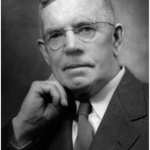
Cecil F. Patterson was born in 1892 in Watford, Ontario. He graduated from the Ontario Agricultural College with a Bachelor of Science degree in Agriculture and afterwards, he received his Masters and Doctorate degrees at Urbana in Illinois. In 1921, he came to the University of Saskatchewan to fulfill the position of teaching horticulture. In 1922, the Department of Horticulture was organized. Cecil was the first Head of the Department of Horticulture and he would fulfill this position for 39 years. During his career, Cecil introduced over 52 new varieties of hardy fruits to the prairies. Cecil is also credited with being the originator of fruit breeding on the prairies. He was a member of the Western Canadian Society for Horticulture, Agricultural Institute of Canada, a Fellow of the American Society for the Advancement of Science, and an honorary member of the Saskatchewan Horticultural Societies Association. In 1973, Cecil was posthumously inducted into the Saskatchewan Agriculture Hall of Fame.
Patterson Garden Arboretum at the University of Saskatchewan is named in his honour. The garden was established in 1966 and contains trees, shrubs, and vines all native to the Prairie Provinces. The site was formally dedicated to Cecil in 1969. Plant species from northern regions of the world are also on display. Beginning in the early 1960s, the Arboretum was originally a trial site to determine if trees, shrubs, and vines could withstand the Prairie Province climate. It was one of the seven sites set up to take part in a prairie wide experiment entitled Prairie Regional Trials for Woody Ornamentals (PRTWO) created by the Modern Research Station in Manitoba. The experiment ended in 2000, but the Patterson Garden Arboretum is still a site of experimentation for new species introduced annually. The Arboretum is open to the public year round and is maintained by the Horticulture Field Facility of the Department of Plant Sciences. The Patterson Garden Arboretum is located on the southeast corner of Preston Avenue North and College Drive. To learn more about the Patterson Garden Arboretum, please call 1-306-966-5855.
C.F. Patterson Park at 330 112th Street and C.F. Patterson Park North located at 330 113th Street in Sutherland are named in his honour. C.F. Patterson Park is 1.3 acres and C.F. Patterson Park North is 2.3 acres in size.
Cecil formerly resided at 1115 Elliott Street.
This information was gathered from the following sources:
– Botanic Gardens Conservation International (n.d.). About the Patterson Garden Aboretum. In Patterson Garden Aboretum. Retrieved from http://www.bgci.org/garden.php?id=3217
– Century 21 (n.d.). Parks and Recreation. Retrieved from http://www.century21.ca/CA/SK/Saskatoon/Neighbourhoods/Sutherland
– College of Agriculture and Bioresources (n.d.). Patterson Garden Arboretum. Retrieved from http://agbio.usask.ca/research/centres-facilities/patterson-garden-arboretum.php
– Henderson’s Saskatoon Directory, 1941.
– Houston, C.S. (n.d.). Patterson, Cecil Frederick (1892-1961). In The Encyclopedia of Saskatchewan. Retrieved from http://esask.uregina.ca/entry/patterson_cecil_frederick_1892-_1961.html.
Thomas Karp Pavlychenko
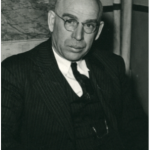
Thomas K. Pavlychenko was born in the Ukraine in 1892. Before coming to Canada in 1927, he studied at the Pedagogical Institute, the College of Agriculture Kamentz-Podilskiy, and the University of Prague. He received his Master of Arts in Agriculture from the University of Saskatchewan in 1932. He went on to receive a PhD in Agriculture from the University of Nebraska. Thomas was posthumously inducted into the Saskatchewan Agricultural Hall of Fame in 1976.
Thomas was a weed experimentalist for the National Research Council from 1930 until 1938. His research in botanics and crop production lead to the discovery of the commonly used herbicide 2-4-D. Thomas’ work also helped to create several business projects in weed control. He established the first Department of Plant Ecology in Canada at the University of Saskatchewan in 1938 and was the Department Head for ten years. He was the first professor of Ukrainian descent in Canada. Thomas taught courses in Ukrainian, which helped to establish the Department of Slavic Studies. In 1948, he left the University of Saskatchewan and accepted a research position for the American Chemical Paint Company.
Under his guidance, the Ukrainian National Federation was created in Saskatoon. Thomas also organized a committee of Ukrainian Canadians, which was the precursor to the Ukrainian Canadian (Committee) Congress. Aside from his professional writings, Thomas also created several bilingual translations for various works. Thomas died on August 6, 1958.
Thomas formerly resided at 1027 Temperance Street.
This information was gathered from the following sources:
– “Dr. Thomas Karp Pavlychenko.” Combined Virtues: Saskatchewan’s Ukrainian Legacy (http://scaa.usask.ca/gallery/ukrainian/; accessed July 18, 2014). University of Saskatchewan, University Archives & Special Collections, 2007-2009.
– Henderson’s Saskatoon Directory, 1941.
– Saskatchewan Agricultural Hall of Fame. (2013). Saskatchewan Agricultural Hall of Fame 25th Anniversary. Retrieved from http://www.sahf.ca/memindx.php
– University of Saskatchewan, University Archives & Special Collections, T.K. Pavlychenko fonds MG 29), finding aid (biographical note).
John George Rayner
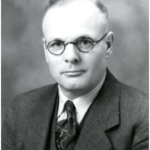
J.G. Rayner was born on October 1, 1890 in London, England. In 1892, he came to Canada with his parents and settled in Elm Valley, Manitoba. In 1913, he received a Bachelor of Science in Agriculture from the Manitoba Agricultural College. In 1914, John became an Agricultural Representative for the Department of Agriculture at the University of Saskatchewan.
He became the Assistant Director of Extension in 1918 and was the Director from 1920 to 1952. In 1921, Mabel Timlin became Rayner’s secretary (she would later become known as a well known Keynesian economic theorist).
John also helped to establish the principles behind the 4-H Movement. The 4-H Foundation’s Camp Rayner was named in his honour in 1965. He was posthumously named to Saskatchewan’s Hall of Fame in 1973. He died on June 30, 1952.
The Rayner Dairy Research and Teaching Facility located at the University of Saskatchewan is named after John. Among other roles, the facility is used as a research centre for the College of Agriculture and Bioresources, College of Engineering, the Western College of Veterinary Medicine, and VIDO/InterVac. The facility opened on October 15, 2013 and is located on Preston Avenue and East Road.
John formerly resided at 1121 Elliott Street.
This information was gathered from the following sources:
– Facilities Management Division. Progress Updates and News. Retrieved from http://facilities.usask.ca/construction_and_renovation/major-projects/rayner-diary-research-and-teaching-facility/progress_updates.php
– Facilities Management Division (n.d.). Rayner Dairy Research and Training Facility. Retrieved from http://facilities.usask.ca/construction_and_renovation/major-projects/rayner-diary-research-and-teaching-facility/index.php
– Henderson’s Saskatoon Directory, 1941.
– University of Saskatchewan, University Archives & Special Collections, J.G. Rayner fonds, (MG 64), finding aid (biographical note).
Edith Childe Rowles Simpson
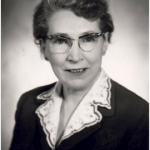
Edith C. Rowles Simpson was born in Manchester, England on April 9, 1905 and was raised on a farm on the Saskatchewan/Alberta border. In 1932, Edith received a Bachelor of Health Sciences degree from the University of Saskatchewan. In 1939, she received a Master’s of Science degree from the University of Wisconsin and in 1956, she received a Doctor of Education degree from Columbia University.
Edith held many positions at the University of Saskatchewan including the Supervisor of Girls Work in 1936, Assistant Professor in the College of Agriculture in 1941, University Dean of Women in 1944, Assistant Professor in the College of Home Economics in 1950, and professor and Dean of the College of Home Economics from 1965 until 1972. She specialized in food science, having taught courses and researched the topic extensively.
Edith was also an accomplished writer, having published the book entitled Home Economics in Canada: Prologue to Change. Edith retired in 1972. The Edith Rowles Simpson Lectureship is named in her honour. In 1993, she was given an honorary Doctor of Laws degree from the University of Saskatchewan. Throughout her career, Edith was involved in many organizations, including the Dietetic Associations of Saskatoon, Saskatchewan, Canada, and America, the Canadian Home Economics Association, as well as the 4-H Council. She was inducted into the Saskatchewan Agricultural Hall of Fame in 1981 and the Order of Canada in 1987. Edith passed away in Saskatoon on December 29, 1997.
The Edith Rowles Simpson Recognition Fund is named after Edith. The fund is administered by the Canadian Home Economics Foundation. The fund provides financial resources for an award given out annually. The award is given to families to help enhance their quality of life. The first award was given out in 1994.
Edith formerly lived at 1015 Osler Street.
This information was gathered from the following sources:
– Canadian Home Economics Foundation (n.d.). Grants and Awards: The Edith Rowles Simpson Recognition Fund. Retrieved from http://www.chef-fcef.ca/grants/grants_edithrowles.htm
– Coneghan, D. (n.d.). Simpson, Edith Chile Rowles (1905-1997). In The Encyclopedia of Saskatchewan. Retrieved from http://esask.uregina.ca/entry/simpson_edith_child_rowles_1905-_97.html
– Henderson’s Saskatoon Directory, 1965.
– University of Saskatchewan, University Archives & Special Collections, ER Simpson fonds (MG 85), finding aid (biographical note).
John William Tranter Spinks
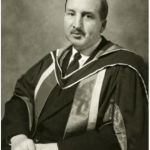
J.W.T Spinks was born on January 1, 1908 in Methwold, England. He received a Bachelor of Science degree in 1928 and a PhD in Chemistry in 1930, both from the University of London. John became an Assistant Professor at the University of Saskatchewan in 1930. He became a Chemistry professor in 1938 and named Head of the Department of Chemistry in 1948. In 1949, he became the Dean of Graduate Studies.
John was named the fourth president of the University of Saskatchewan in 1959 and retired from this position in 1974. During his career, he published more than 260 scientific works. He has been awarded many honours, including a doctorate level academic degree of Law from the University of Saskatchewan, Companion of the Order of Canada in 1970, and was awarded the Order of the British Empire in 1943 for his development of rescue procedures for missing aircrafts during World War II. In 1996, John was awarded the Saskatchewan Order of Merit, which is awarded to individuals showing great achievements in their field. He passed away in Saskatoon on March 27, 1997. Spinks Drive in Greystone Heights is named in his honour.
The Spinks Addition located at the University of Saskatchewan is named in his honour.
John formerly resided at 1031 University Drive.
This information was gathered from the following sources:
– Duerkop, J. (2000). Saskatoon’s History in Street Names. Saskatoon: Purich Publishing Ltd.
– Henderson’s Saskatoon Directory, 1941.
– Secoy, D. (n.d.). Spinks, John William Tranter (1908-1997). In The Encyclopedia of Saskatchewan. Retrieved from http://esask.uregina.ca/entry/spinks_john_william_tranter_1908-_97.html
– University of Saskatchewan, University Archives & Special Collections, J.W.T. Spinks Fonds (MG 74), finding aid (biographical note).
Mabel Frances Timlin
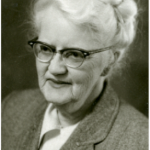
Mabel Timlin was born on December 6, 1891 in Forest Junction, Wisconsin. Mabel attended school in Wisconsin Rapids and Port Edwards, Wisconsin. Prior to accepting a secretarial position at the University of Saskatchewan in 1921, Mabel attended the Milwaukee State Normal School from 1910 to 1912. She taught school in Wisconsin before heading to Winnipeg and then Saskatchewan. While in Saskatchewan, Mabel taught school in Bounty and Wilkie. A few years later, Mabel left teaching in rural Saskatchewan to take a business course at the Saskatoon Business College. By 1920, she was teaching at the Saskatoon Business College. In 1921, Mabel left this position to become Secretary to John George Rayner, Director of the Department of Agricultural Extension at the University of Saskatchewan.
While working full time at the University of Saskatchewan, Mabel completed her first degree. In 1929, she graduated with great distinction and received a Bachelor of Arts degree in English. However, she was not satisfied with a Bachelor of Arts degree. In 1932, she enrolled in a graduate program at the University of Washington. While obtaining her degree, Mabel joined the Economics Department at the University of Saskatchewan in 1935. Due to her full time job at the University of Saskatchewan, Mabel completed most of her graduate work in the summer months. She spent the winter term of 1934 and the academic year of 1939 to 1940 at the University of Washington. Mabel received a PhD in Economics in 1940 from the University of Washington. She completed her doctoral thesis Keynesian Economics- A Synthesis in 1940. The thesis was published by the University of Toronto in 1942. Mabel was appointed Assistant Professor of Economics at the University of Saskatchewan in 1941, Associate Professor of Economics in 1946, and full professor in 1950. Mabel retired as Professor Emiratis in 1959. After her retirement in 1959, she received a Canada Council Special Senior Fellowship, allowing her to travel and continue her studies on Canadian immigration policy.
During her career, Mabel received many awards. In 1945, she was awarded the Guggenheim Fellowship. In 1951, she became the first female social scientist to be elected to the Royal Society of Canada. In 1952, she was elected to the Royal Commission for the Saskatchewan River Development. Mabel was Vice President of the Canadian Political Science Association from 1953 to 1955 and the first female President of the association from 1959 to 1960. From 1957 to 1960, she was the first woman to be elected to the American Economics Association. Throughout her career, Mabel was a strong advocate for equality and was very aware of the implications of low pay for women, especially single women. In 1961, she wrote a letter to the University of Saskatchewan President J.W.T. Spinks outlining the low pay and difficult working conditions. Mabel received Canada’s Centennial Medal in 1967 and was given an honourary degree of Doctor of Laws in 1969 by the University of Saskatchewan. She became a member of the Order of Canada in 1976. Mabel passed away on September 20, 1976.
Mabel formerly resided at 1036 College Drive.
This information was gathered from the following sources:
– Ainley, M.G. (1996). Mabel Frances Timlin, FRSC (1891-1976). In Canadian Women Economists Network. Retrieved from http://www.yorku.ca/cwen/aad1e_Timlin.html